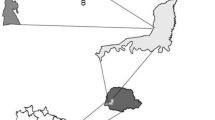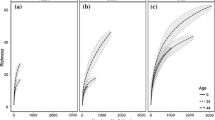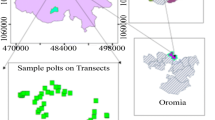Abstract
In spite of its high diversity the forests in Southern Ecuador are highly endangered by deforestation. One of the main reasons for the loss of forests is the conversion into pastures. Due to their fast degradation, the pastures are abandoned after several years and form an increasing area of unproductive land. The remoteness from existing forest edges is discussed as one reason for the very slow natural reforestation of these areas. In this study we analyzed the regeneration of a secondary forest after approx. 38 years of succession in relation to the distance from the surrounding forest. We revealed that regeneration was rather slow. Especially larger trees with dbh > 10 cm were very scarce. Only Dioicodendron dioicum, Graffenrieda emarginata and Clusia sp. achieved larger diameters. The basal area of the secondary forest is still far beyond the original level in the primary forest. The number of species on plot level and the Shannon index were significantly lower in the secondary forest compared to the primary forest. The total number of species decreased from 47 to 31 with increasing distance from the forest edge and the similarity of species composition to the upper story declined to a level of 56.4 (Sörensen). Alzatea verticillata, Macrocarpea revoluta and Palicourea andaluciana had significantly higher abundances in the succession stages than in the natural forest. The most abundant species in all regeneration plots, G. emarginata and Purdiea nutans, seem to be generalists as they did not show preference either to natural forest or successional stages.





Similar content being viewed by others
Notes
Species that only occur at a single position along the gradient from the forest to the gap center, for example only inside the forest but nowhere else
Different numbers indicate different morphospecies
References
Aide TM, Zimmermann JK, Pascarella JB, Rivera L, Marcano-Vega H (2000) Forest regeneration in a chronosequenze of tropical abandoned pastures: implications for restoration ecology. Restor Ecol 8(4):328–338
Almeida K, Arguero A, Clavijo X, Matt F, Zamora J (2004) Dispersion de semillas por aves, murcielago y viento en áreas disturbadas de un bosque montano en el suroriente ecuatoriano. Anual Symposium of DFG Reserach Group, Loja, Ecuador
Amelung T, Diehl M (1992) Deforestation of tropical rainforests: economic causes and impact on development. Mohr, Germany
Barthlott W, Lauer W, Placke A (1996) Global distribution of species diversityin vascular plants: towards a world map pf phytodiversity. Erdkunde 50(4):317–327
Braun H (2001) Die Laubheuschrecken (Orthoptera, Tettigoniidae) eines Bergregenwaldes in Süd-Ecuador—faunistische, bioakustische und ökologische Untersuchungen. Dissertation, University of Erlangen-Nürnberg
Brehm G (2002) Diversity of geometrid moths in a montane rainforest. Univ. Bayreuth, Doktorarbeit, p 196
Brokaw N, Busing RT (2000) Niche versus chance and tree diversity in forest gaps. Trends Ecol Evol 15:183–188
Brown S, Sayant J, Cannel M, Kauppi PE (1996) Mitigation of carbon emissions to the atmosphere by forest management. Commonweal For Rev 75:80–91
Brummit N, Lughadha EC (2003) Where’s hot and where’s not. Conserv Biol 17(5):1442–1448
Bussmann RW (2001) The montane forests of Reserva Biologica San Francisco (Zamora Chinchipe, Ecuador)—vegetation zonationand natural regeneration. Die Erde 132:11–24
Connell JH (1978) Diversity in tropical rain forests and coral reefs. Science 199:1302–1310
Connell JH (1979) Tropical rain forests and coral reefs as open non-equilibrium systems. In: Anderson RM (ed) Population dynamics. British Ecological Society, pp 141–163
Cubiña A, Aide TM (2001) The effect of distance from forest edge on seed rain and soil seed bank in a tropical pasture. Biotropica 33(2):260–267
Eckert Th (2006) Biomasseuntersuchung an jungen Aufforstungspflanzen von Tabebuia chrysantha und Cedrela mont in Südecuador. Master’s Thesis, Studienfakultät Forstwissenschaft und Ressourcenmanagement der Technischen Universität München, p 73S
Emck P (2006) A climatology of South Ecuador—with special focus on the major Andean Range as Atlantic–Pacific Climate Divide. Ph.D. thesis, University of Erlangen, Germany
Engel VL, Parrotta JA (2001) An evaluation of direct seeding for reforestation of degraded lands in central Sao Paolo State, Brazil. For Ecol Manage 152:169–181
FAO (2006) Global Forest Resources Assessment 2005. Progress towards sustainable forest management. Food and Agricultural Organization of the United nations, Rome, pp 320
Finegan B, Delgado D (2000) Structural and floristic heterogeneity in a 30-year old Costa Rican forest restored on pasture through natural secondary succession. Restor Ecol 8(4):380–393
Gálvez JR, Ordoñez GOR, Bussmann RW (2001) Estructura del bosque montano perturbado y no-perturbado en el Sur de Ecuador. In: Bussmann RW, Lange S (eds) First congress of conservation of biodiversity in the Andes and the Amazon. Cuzco, Peru
Garzia-Martinez C, Howe HF (2003) Restoring tropical diversity: beating the time tax on species loss. J Appl Ecol 49:423–429
Grau HR (2002) Scale dependent relationships between treefalls and species richness in a neotropical montane forest. Ecology 83(9):2591–2601
Günter S (2001) Ökologie und Verjüngung von Mahagoni (Swietenia macrophylla King) in Naturwäldern Boliviens. Ph.D. Thesis, Universität Göttingen. Cuvillier Verlag Göttingen, pp 185
Günter S, Mosandl R (2003) Nachhaltige Bewirtschaftung von Bergregenwäldern Südecuadors. In Mosandl R, El Kateb H, Stimm B (eds) Waldbau—weltweit. Beiträge zur internationalen Waldbauforschung. Forstl. Forschungsberichte München, vol 192, pp 10–23
Hecht SB (1993) The logic of livestock and deforestation in Amazonia. Bioscience 43:687–695
Henderson A, Churchill S-P, Luteyn JL (1991) Neotropical plant diversity. Nature 351:21–22
Hilpmann J (2003) Waldwachstumskundliche Untersuchungen an zwei Höhentransekten im tropischen Bergregenwald Südecuadors. B.Sc. Thesis, Technische Universität Dresden, Germany
Holl KD, Loik ME, Eleanor HVL, Samuels IA (2000) Tropical montane forest restoration in Costa Rica: overcoming barriers to dispersal and establishment. Restor Ecol 8(4):339–349
Homeier J (2004) Baumdiversität, Waldstruktur und Wachstumsdynamik zweier tropischer Bergregenwälder in Ecuador und Costa Rica. Dissertation, Universität Bielefeld
Homeier J, Dalitz H, Breckle SW (2002) Waldstruktur und Baumartendiversität im montanen Regenwald der Estación Científica San Francisco in Südecuador. Berichte der Reinhold-Tüxen-Gesellschaft 14:109–118
Howe HF, Smallwood J (1982) Ecology of seed dispersal. Ann Rev Ecol Syst 13:201–228
Hubbel SP et al (1999) Light gap disturbances, recruitment limitation, and tree diversity in a neotropical forest. Science 283:554–557
Lamprecht H (1986) Waldbau in den Tropen. Paul Parey, Hamburg
Li J, Loneragan WA, Duggin JA, Grant CD (2004) Issues affecting the measurement of disturbance response patterns in herbaceous vegetation—a test of the intermediate disturbance hypothesis. Plant Ecol 172:11–26
Matt F (2001) Pflanzenbesuchende Fledermäuse im tropischen Bergregenwald: Diversität, Einnischung und Gildenstruktur. Eine Untersuchung der Fledermausgemeinschaften in drei Höhenstufen der Andenostabdachung des Podocarpusnationalparks in Südecuador. Dissertation at Friedrich-Alexander-University, Erlangen-Nürnberg, p 101
Molino J-F, Sabatier D (2001) Tree diversity in tropical rain forests: a validation of the intermediate disturbance hypothesis. Science 294:1702–1704
Muuß U (1997) Anreicherungspflanzungen in Moorwäldern auf Sumatra. Göttinger Beiträge zur Land- und Forstwirtschaft in den Tropen und Subtropen, vol 119, p 160
Myster W (2004) Regeneration filters in post-agricultural fields in Puerto Rico and Ecuador. Vegetation 172:199–209
Nangendo G, Stein A, Gelens M, de Gier A, Albricht R (2002) Quantifying differences in biodiversity between a tropical forest area and a grassland area subject to traditional burning. For Ecol Manage 164:109–120
Olffa H, Ritchie ME (2002) Fragmented nature: consequences for biodiversity. Landsc Urban Plan 58:83–92
Paulsch A (2002) Development and application of a classification system for undisturbed and disturbed tropical montane forests based on vegetation structure. Dissertation, University of Bayreuth
Pedraza RA, Williams-Linera G (2003) Evaluation of native tree species for the rehabilitation of deforested areas in a Mexican cloud forest. New For 26:83–99
Poorter L, Arets EJMM (2003) Light environment and tree strategies in a Bolivian tropical moist forest: an evaluation of the light partitioning hypothesis. Plant Ecol 166:295–306
Potts MD (2003) Drought in a Bornean everwet rain forest. J Ecol 91:467–474
Schrumpf M (1999) Genese, Klassifikation und Nährstoffgehalte tropischer Böden entlang eines Höhentransekts an der Andenostabdachung Südecuadors. Diploma thesis section Geoecology, Universität Bayreuth
Schwilk DW, Keeley JE, Bond WJ (1997) The intermediate disturbance hypothesis does not explain fire diversity pattern in fynbos. Plan Ecol 132:77–84
Sheil D, Burslem DFRP (2003) Disturbing hypotheses in tropical forests. Trends Ecol Evol 18(1):18–26
Swaine WD, Hall JB (1988) The mosaic theory of forest regeneration and the determination of forest composition in Ghana. J Tropical Ecol 4:253–269
Zimmermann JK, Aide TM, Rosario M, Serrano, Herrera L (1995) Effects of land management and a recent hurricane on forest structure and composition in the Luquillo Experimental Forest, Puerto Rico. For Ecol Manage 77:65–76
Zimmermann JK, Pascarella JB, Aide TM (2000) Barriers to forest regeneration in a abandoned pasture in Puerto Rico. Restor Ecol 8(4):350–360
Acknowledgments
We wish to express our gratitude to the German Research Foundation DFG and the Foundation “Nature and Culture International” for financial assistance. To Alfredo Martinez and Jürgen Homeier our thanks for providing support with botanical identification. We also like to thank the Ministerio de Ambiente del Ecuador for the research permit. Finally, we thank Bernd Stimm for literature and Edith Lubitz for the revision of the manuscript. Last but not the least we thank the team of the Scientific Station San Francisco for their help and the fun we had researching together.
Author information
Authors and Affiliations
Corresponding author
Additional information
Communicated by Hans Pretzsch.
Rights and permissions
About this article
Cite this article
Günter, S., Weber, M., Erreis, R. et al. Influence of distance to forest edges on natural regeneration of abandoned pastures: a case study in the tropical mountain rain forest of Southern Ecuador . Eur J Forest Res 126, 67–75 (2007). https://doi.org/10.1007/s10342-006-0156-0
Received:
Accepted:
Published:
Issue Date:
DOI: https://doi.org/10.1007/s10342-006-0156-0




